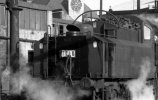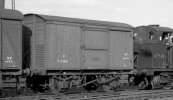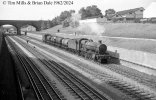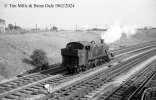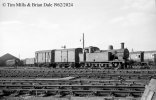AJC
Western Thunderer
Haha - I have no interest in the loco or wagon, however the location.....
I would say this is taken at the bridge where the North London Line crosses the Central line at the back of Old Oak Common (there were a few footpaths in the area) and only started looking as a third rail is visible suggested by the cables and hangers indicating it's somewhere on the North London Line.
The annotated the NLS extract of the OS 1:2,500 A ed. 1848-1973 series map to show the location. At this period the North London Line was electrified at 630V DC 3rd rail (same as LT) for it's route. Today it is electrified at 25kV AC fron Stratford to Acton Central where it changes over to 630v DC third rail towards Richmond. North Acton Central Line Station is about 340m (370 yards) down the line under the bridge to the left as viewed.
In the background of the photo there appears to be some shear legs/derrick which would be commensurate with the Scrap Metal Yard shown on the map extract.
View attachment 214295
Regarding the area containing the scrap metal yard off Victoria Road below is an extract from British History On-Line Acton: Economic history A History of the County of Middlesex: Volume 7, Acton, Chiswick, Ealing and Brentford, West Twyford, Willesden Originally published by Victoria County History, London, 1982. Acton: Economic history | British History Online
During the First World War, Park Royal was used as a large horse compound for the Royal Army Service Corps. (fn. 120) Munitions factories, employing mainly Willesden residents, were built in Willesden Lane and Victoria Road, Acton, and closed towards the end of 1918, (fn. 121) becoming derelict. In 1928 the government sold 5 a. with their buildings to Allnatt Ltd., for scrap metal sorting, and offers received for the premises revealed a growing demand for small ready-built factories. (fn. 122)
Ah, you've lit on the day job! The Victoria County History (VCH) is my manor (for my sins, I'm its General Editor as the series continues today). Nice to see it deployed in fleshing out this sort of observation.

Adam
Last edited:

